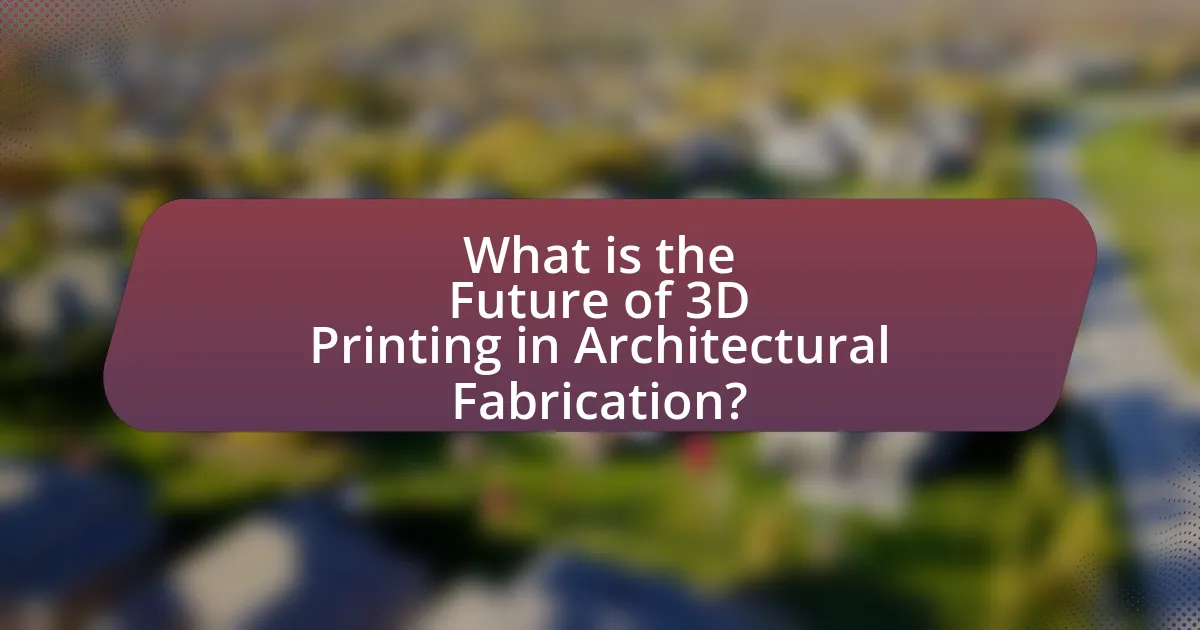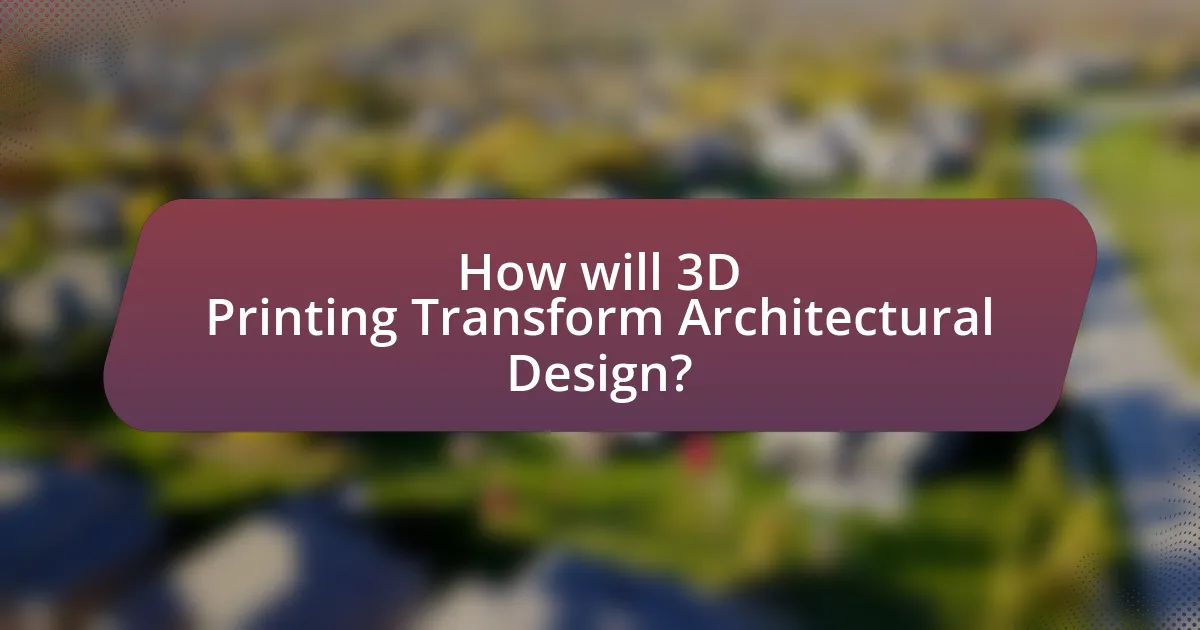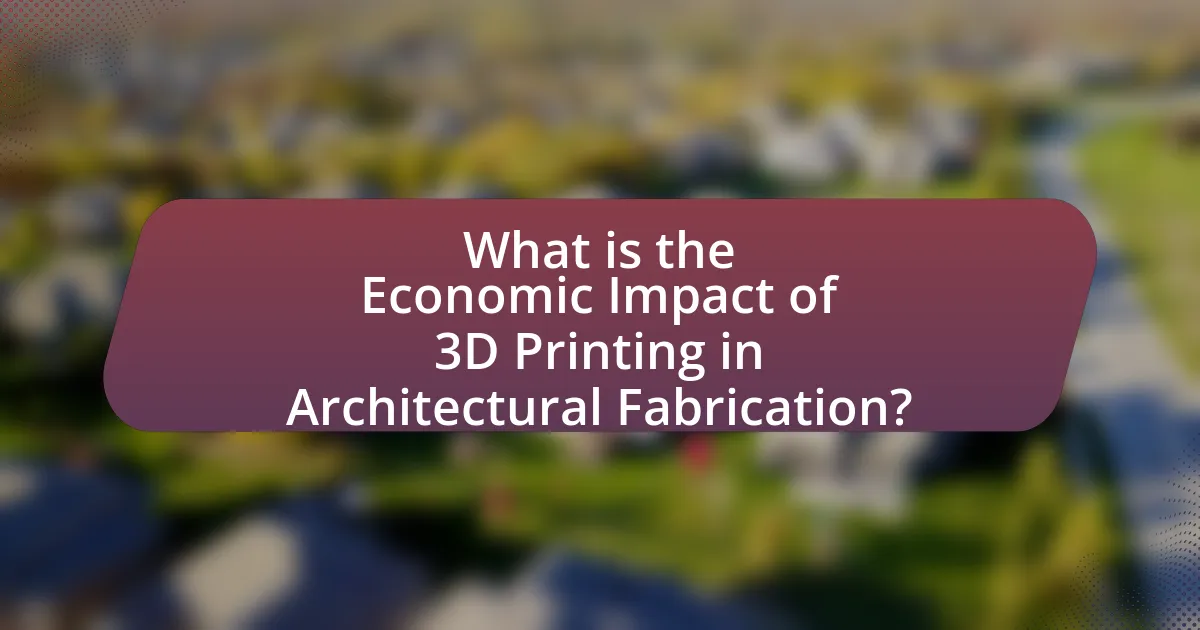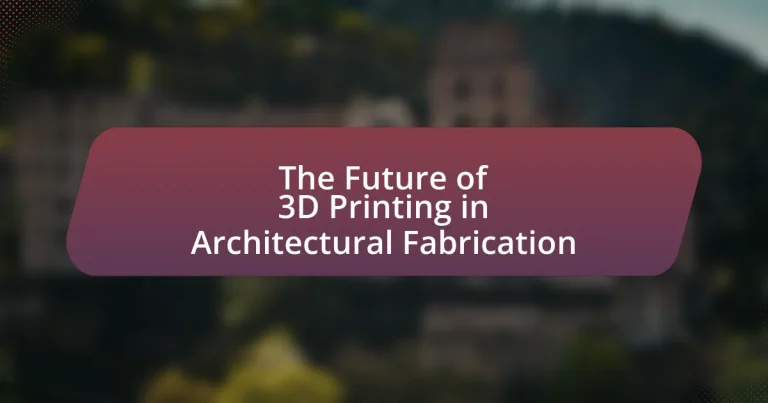The article focuses on the future of 3D printing in architectural fabrication, highlighting advancements in materials and technology that are set to transform the construction industry. It discusses the current applications of 3D printing, including the creation of complex structures with reduced waste and labor costs. Key technologies driving this innovation include additive manufacturing techniques and advanced materials, while potential advancements promise increased sustainability and customization. The article also addresses challenges such as material limitations and regulatory hurdles, alongside the economic impact of 3D printing, which includes significant cost savings and efficiency improvements in construction processes.

What is the Future of 3D Printing in Architectural Fabrication?
The future of 3D printing in architectural fabrication is poised for significant advancements, driven by innovations in materials and technology. As of 2023, the integration of sustainable materials, such as bio-based and recycled composites, is expected to enhance the environmental impact of construction processes. Additionally, the use of large-scale 3D printers will enable the creation of complex structures that traditional methods cannot achieve, reducing waste and construction time. Research indicates that 3D printing can decrease labor costs by up to 50% and construction time by 70%, making it a more efficient alternative. Furthermore, the rise of digital fabrication techniques will allow for greater customization and adaptability in architectural design, catering to specific client needs and site conditions.
How is 3D printing currently used in architectural fabrication?
3D printing is currently used in architectural fabrication to create complex building components and entire structures with high precision and reduced material waste. This technology enables architects and builders to produce intricate designs that would be difficult or impossible to achieve with traditional construction methods. For instance, companies like ICON have successfully 3D printed homes in less than 24 hours, demonstrating the speed and efficiency of this method. Additionally, research from the University of Southern California highlights that 3D printing can reduce construction costs by up to 50% while allowing for customization and rapid prototyping of architectural elements.
What technologies are driving 3D printing in architecture?
The technologies driving 3D printing in architecture include additive manufacturing techniques, advanced materials, and digital design software. Additive manufacturing allows for the layer-by-layer construction of complex structures, enabling architects to create innovative designs that were previously unfeasible. Advanced materials, such as concrete composites and bio-based filaments, enhance the durability and sustainability of printed structures. Digital design software, including Building Information Modeling (BIM) and parametric design tools, facilitates precise modeling and integration of 3D printing processes into architectural workflows. These technologies collectively transform architectural fabrication by improving efficiency, reducing waste, and expanding design possibilities.
What materials are commonly used in 3D printing for architecture?
Common materials used in 3D printing for architecture include concrete, plastics, metals, and composites. Concrete is favored for its strength and durability, allowing for large-scale structures. Plastics, such as PLA and ABS, are often used for prototypes and smaller components due to their ease of use and versatility. Metals, including aluminum and stainless steel, are utilized for their structural integrity in high-performance applications. Composites combine materials to enhance properties like weight and strength, making them suitable for innovative architectural designs. These materials are selected based on their specific properties that meet the demands of architectural fabrication.
What potential advancements can we expect in 3D printing for architecture?
Potential advancements in 3D printing for architecture include the development of more sustainable materials, increased printing speed, and enhanced design capabilities. Sustainable materials, such as bio-based and recycled composites, are being researched to reduce the environmental impact of construction. Increased printing speed is being achieved through innovations in printer technology, allowing for faster construction timelines. Enhanced design capabilities are facilitated by advanced software that enables complex geometries and customized structures, which can lead to more efficient use of space and resources. These advancements are supported by ongoing research and development in the field, indicating a significant evolution in architectural fabrication practices.
How might new materials enhance architectural designs?
New materials can significantly enhance architectural designs by enabling greater flexibility, sustainability, and efficiency in construction. Advanced composites, for instance, allow for lighter structures that maintain strength, while bio-based materials contribute to eco-friendly building practices. Research indicates that the use of 3D printing with innovative materials can reduce waste by up to 70% compared to traditional methods, as demonstrated in projects like the ICON 3D-printed homes, which utilize concrete mixtures optimized for durability and cost-effectiveness. These advancements not only improve the aesthetic appeal of buildings but also promote energy efficiency and reduce the carbon footprint of construction.
What role will automation play in the future of architectural 3D printing?
Automation will significantly enhance the efficiency and precision of architectural 3D printing in the future. By integrating automated systems, the construction process can achieve faster production times, reduce human error, and lower labor costs. For instance, automated 3D printers can operate continuously, producing complex structures with high accuracy, which is crucial for meeting the increasing demand for innovative architectural designs. Additionally, automation allows for real-time monitoring and adjustments during the printing process, ensuring optimal material usage and minimizing waste. This shift towards automation is supported by advancements in robotics and AI, which are already being implemented in various construction projects, demonstrating their potential to revolutionize the architectural 3D printing landscape.
What challenges does 3D printing face in architectural fabrication?
3D printing in architectural fabrication faces several challenges, including material limitations, regulatory hurdles, and scalability issues. Material limitations arise because not all construction materials are suitable for 3D printing, which restricts design possibilities and structural integrity. Regulatory hurdles exist as building codes and standards often do not accommodate 3D-printed structures, leading to delays in approval processes. Scalability issues are evident as current 3D printing technologies may not efficiently produce large-scale structures within the required timeframes, impacting project timelines and costs. These challenges hinder the widespread adoption of 3D printing in the architectural sector.
How do regulatory issues impact the adoption of 3D printing in architecture?
Regulatory issues significantly hinder the adoption of 3D printing in architecture by creating barriers related to building codes, safety standards, and zoning laws. These regulations often lag behind technological advancements, resulting in uncertainty for architects and builders who wish to implement 3D printing techniques. For instance, many jurisdictions lack specific guidelines for materials and processes used in 3D printing, which can lead to delays in project approvals and increased costs. Furthermore, the absence of standardized regulations can deter investment in 3D printing technologies, as stakeholders may perceive higher risks associated with compliance and liability.
What are the limitations of current 3D printing technologies in architecture?
Current 3D printing technologies in architecture face several limitations, including material constraints, scalability issues, and regulatory challenges. The range of materials suitable for 3D printing is still limited, primarily focusing on concrete and plastics, which restricts design flexibility and structural performance. Additionally, the scalability of 3D printing processes is often inadequate for large-scale projects, as most printers are designed for smaller components rather than entire buildings. Regulatory challenges also hinder the adoption of 3D printing in architecture, as building codes and standards have not yet fully adapted to accommodate this technology, leading to uncertainties in safety and compliance. These limitations collectively impact the widespread implementation of 3D printing in architectural practices.

How will 3D Printing Transform Architectural Design?
3D printing will transform architectural design by enabling rapid prototyping, customization, and cost-effective construction methods. This technology allows architects to create complex structures that were previously impossible or too expensive to build using traditional methods. For instance, 3D printing can reduce material waste by up to 90% compared to conventional construction techniques, as it uses only the necessary amount of material for each design. Additionally, projects like the 3D-printed houses in Mexico demonstrate how this technology can significantly decrease construction time, with some homes being completed in just a few days. These advancements indicate a shift towards more sustainable and innovative architectural practices.
What innovative design possibilities does 3D printing offer architects?
3D printing offers architects innovative design possibilities such as complex geometries, customized structures, and rapid prototyping. This technology enables the creation of intricate designs that would be difficult or impossible to achieve with traditional construction methods, allowing for unique architectural expressions. For instance, the use of 3D printing can reduce material waste by optimizing the design process, as seen in projects like the 3D-printed “Office of the Future” in Dubai, which showcases the potential for sustainable building practices. Additionally, architects can quickly iterate on designs, facilitating faster project development and enabling the exploration of new forms and functions in architecture.
How can 3D printing facilitate complex geometries in architecture?
3D printing facilitates complex geometries in architecture by enabling the creation of intricate designs that traditional construction methods cannot achieve. This technology allows architects to produce customized components with high precision and flexibility, accommodating unique shapes and forms that enhance aesthetic and functional aspects of buildings. For instance, structures like the “D-Shape” project in Italy demonstrate how 3D printing can create complex, organic forms using a layer-by-layer additive process, which minimizes material waste and reduces construction time. Additionally, research from the University of Southern California highlights that 3D printing can produce geometrically complex structures that are both lightweight and structurally sound, further validating its role in advancing architectural innovation.
What are the implications of customization in architectural design through 3D printing?
Customization in architectural design through 3D printing significantly enhances design flexibility and efficiency. This technology allows architects to create complex geometries and tailored structures that traditional methods cannot achieve, leading to innovative designs that meet specific client needs. For instance, a study by the University of Southern California demonstrated that 3D printing can reduce material waste by up to 60% compared to conventional construction methods, thereby promoting sustainability. Additionally, customization through 3D printing can accelerate the construction process, with projects being completed in a fraction of the time, as evidenced by the successful 3D-printed homes built in less than 24 hours. These implications indicate that 3D printing is transforming architectural design by enabling personalized, efficient, and sustainable building practices.
How does 3D printing influence sustainability in architecture?
3D printing significantly influences sustainability in architecture by reducing material waste and enabling the use of eco-friendly materials. Traditional construction methods often result in substantial waste due to excess materials and inefficiencies, whereas 3D printing allows for precise material usage, minimizing off-cuts and surplus. For instance, a study by the University of Southern California found that 3D printing can reduce material waste by up to 60% compared to conventional building techniques. Additionally, 3D printing facilitates the incorporation of sustainable materials, such as recycled plastics and bio-based composites, further enhancing the environmental performance of architectural projects.
What are the environmental benefits of using 3D printing in construction?
The environmental benefits of using 3D printing in construction include reduced material waste, lower carbon emissions, and the ability to utilize sustainable materials. 3D printing technology minimizes excess material usage by precisely depositing only what is needed, which can lead to a reduction of up to 60% in waste compared to traditional construction methods. Additionally, 3D printing can significantly lower carbon emissions by streamlining the construction process and reducing the energy required for transportation and assembly. Furthermore, advancements in 3D printing allow for the incorporation of eco-friendly materials, such as recycled plastics and bio-based composites, promoting sustainability in the construction industry.
How can 3D printing reduce waste in architectural projects?
3D printing can significantly reduce waste in architectural projects by enabling precise material usage and minimizing excess. Traditional construction methods often result in substantial waste due to over-ordering materials and inefficient cutting processes. In contrast, 3D printing allows for additive manufacturing, where materials are deposited layer by layer only where needed, thus optimizing resource consumption. For instance, a study by the University of Southern California found that 3D printing can reduce material waste by up to 60% compared to conventional building techniques. This efficiency not only conserves resources but also lowers costs associated with waste disposal and material procurement.

What is the Economic Impact of 3D Printing in Architectural Fabrication?
The economic impact of 3D printing in architectural fabrication is significant, primarily due to cost reduction, increased efficiency, and the potential for innovative design. 3D printing can lower material costs by up to 60% compared to traditional construction methods, as it minimizes waste and allows for the use of less expensive materials. Additionally, projects can be completed 40% faster, which reduces labor costs and accelerates time-to-market for new buildings. A study by the McKinsey Global Institute highlights that the construction industry could save $1.6 trillion annually through the adoption of advanced technologies like 3D printing. This technology also enables architects to create complex structures that were previously unfeasible, potentially leading to new market opportunities and increased competitiveness in the architectural sector.
How does 3D printing affect construction costs?
3D printing significantly reduces construction costs by minimizing material waste and labor expenses. Traditional construction methods often lead to excess material usage, whereas 3D printing utilizes only the necessary amount of material, which can decrease costs by up to 30%. Additionally, 3D printing can automate the construction process, reducing the need for skilled labor and further lowering labor costs. A study by the University of Southern California found that 3D-printed structures can be completed in a fraction of the time compared to conventional building methods, leading to substantial savings in project timelines and associated costs.
What are the cost savings associated with 3D printing in architecture?
3D printing in architecture can lead to significant cost savings by reducing material waste, labor costs, and construction time. Traditional construction methods often result in up to 30% material waste, whereas 3D printing optimizes material usage, minimizing excess. Additionally, 3D printing can cut labor costs by up to 50% due to automation and the ability to produce complex structures without extensive manual labor. Furthermore, projects can be completed in a fraction of the time, with some estimates suggesting a reduction in construction time by 50% or more, leading to lower overhead costs. These factors collectively contribute to a more economical approach to architectural fabrication.
How does 3D printing influence labor costs in construction?
3D printing significantly reduces labor costs in construction by automating the fabrication process and minimizing the need for manual labor. Traditional construction methods often require a large workforce for tasks such as formwork, masonry, and finishing, which can be labor-intensive and time-consuming. In contrast, 3D printing technology can produce complex structures with minimal human intervention, allowing for faster project completion and reduced labor hours. For instance, a study by the University of Southern California found that 3D printing can decrease labor costs by up to 50% compared to conventional building methods. This reduction in labor costs is further supported by the ability of 3D printers to operate continuously, leading to increased efficiency and productivity on construction sites.
What market trends are shaping the future of 3D printing in architecture?
The future of 3D printing in architecture is being shaped by trends such as increased adoption of sustainable materials, advancements in technology, and a growing demand for customization. Sustainable materials, including bio-based and recycled options, are gaining traction as architects seek to reduce environmental impact; for instance, the use of concrete alternatives made from waste materials is on the rise. Technological advancements, particularly in software and hardware, are enhancing the precision and efficiency of 3D printing processes, allowing for more complex designs and faster production times. Additionally, the demand for customized architectural solutions is driving innovation, as clients increasingly seek unique designs tailored to their specific needs. According to a report by MarketsandMarkets, the global 3D printing market in construction is projected to reach $1.5 billion by 2024, reflecting the significant growth and investment in this sector.
How is the demand for 3D printed structures evolving in the architectural market?
The demand for 3D printed structures in the architectural market is rapidly increasing due to advancements in technology and a growing emphasis on sustainability. Architectural firms are increasingly adopting 3D printing to create complex designs that are cost-effective and environmentally friendly. According to a report by MarketsandMarkets, the global 3D printing construction market is projected to grow from $40 million in 2020 to $1.5 billion by 2025, reflecting a compound annual growth rate (CAGR) of 89.5%. This surge is driven by the ability of 3D printing to reduce material waste and construction time, making it an attractive option for modern building projects.
What role do startups play in advancing 3D printing technologies for architecture?
Startups play a crucial role in advancing 3D printing technologies for architecture by driving innovation, developing new materials, and creating cost-effective solutions. These companies often operate with agility, allowing them to experiment with novel designs and techniques that larger firms may overlook. For instance, startups like ICON and Apis Cor have pioneered the use of concrete 3D printing to construct affordable housing, demonstrating the potential for rapid construction and reduced labor costs. Their advancements contribute to the broader adoption of 3D printing in the architectural sector, as evidenced by the increasing number of projects utilizing these technologies globally.
What best practices should architects follow when integrating 3D printing?
Architects should prioritize design optimization, material selection, and collaboration when integrating 3D printing into their workflows. Design optimization involves creating models that leverage the unique capabilities of 3D printing, such as complex geometries and lightweight structures, which can enhance both aesthetics and functionality. Material selection is crucial; architects must choose materials that are compatible with 3D printing technologies and suitable for the intended application, ensuring durability and sustainability. Collaboration with engineers and manufacturers is essential to align design intentions with practical printing capabilities, facilitating a smoother production process. These practices are supported by industry trends indicating that optimized designs and appropriate material choices can significantly reduce waste and construction time, ultimately leading to more efficient architectural outcomes.
How can architects effectively collaborate with 3D printing specialists?
Architects can effectively collaborate with 3D printing specialists by establishing clear communication and integrating design processes early in the project. This collaboration involves architects sharing detailed design specifications and constraints, allowing 3D printing specialists to provide insights on material properties and printing techniques that can enhance the design. For instance, a study by the University of Southern California highlighted that early involvement of 3D printing experts can reduce material waste by up to 30%, demonstrating the efficiency gained through such partnerships. Additionally, utilizing collaborative software tools can streamline the workflow, ensuring that both parties remain aligned throughout the project lifecycle.
What considerations should be made for material selection in 3D printed architecture?
Material selection in 3D printed architecture should prioritize mechanical properties, sustainability, and compatibility with printing technology. Mechanical properties, such as strength, flexibility, and thermal resistance, are crucial for ensuring structural integrity and performance under various conditions. Sustainability considerations involve choosing materials that minimize environmental impact, such as recycled plastics or bio-based composites, which can reduce carbon footprints. Compatibility with printing technology is essential, as different 3D printing methods, like FDM or SLA, require specific material characteristics to achieve optimal results. For instance, thermoplastics like PLA and ABS are commonly used in FDM due to their ease of use and availability.





